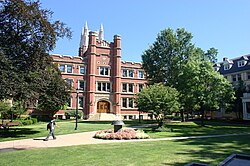
Colin McLarty (born July 12, 1951) is an American logician whose publications have ranged widely in philosophy and the foundations of mathematics, as well as in the history of science and of mathematics.

Colin McLarty (born July 12, 1951) is an American logician whose publications have ranged widely in philosophy and the foundations of mathematics, as well as in the history of science and of mathematics.
He has written papers about Saunders Mac Lane, one of the founders of category theory.
McLarty's Elementary Categories and Elementary Toposes describes category theory and topos theory at an elementary level. [1]
McLarty worked on establishing that Fermat's Last Theorem can be proven in a setting with much weaker assumptions than the ones used in Wiles's proof of Fermat's Last Theorem, which makes use of involved category theoretical constructions. [2]
He is a member of the Grothendieck Circle, which provides on-line and open access to many writings about the mathematician Alexandre Grothendieck, who revolutionized Banach-space theory and algebraic geometry and whose life has fascinated many biographers and mathematical scientists. [3]
McLarty has also written about the German algebraist Emmy Noether and her involvement with German political history. [4]

At Case Western Reserve University (CWRU), Colin McLarty is the Truman P. Handy Professor of Philosophy and the current Chair of the Philosophy Department. [5]
At CWRU, he is also a professor of mathematics.